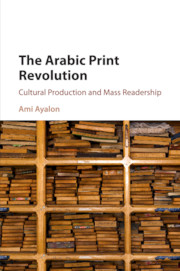Book contents
- Frontmatter
- Dedication
- Contents
- Preface and Acknowledgments
- Introduction
- 1 The Formative Phase of Arab Printing: A Historical Overview
- 2 Printers and Publishers
- 3 Books, Journals, Cartes de visite
- 4 Diffusion Channels
- 5 Advancing Circulation
- 6 Reading and Readers
- 7 Reading in Public
- Conclusion
- Bibliography
- Index
Conclusion
Published online by Cambridge University Press: 05 September 2016
- Frontmatter
- Dedication
- Contents
- Preface and Acknowledgments
- Introduction
- 1 The Formative Phase of Arab Printing: A Historical Overview
- 2 Printers and Publishers
- 3 Books, Journals, Cartes de visite
- 4 Diffusion Channels
- 5 Advancing Circulation
- 6 Reading and Readers
- 7 Reading in Public
- Conclusion
- Bibliography
- Index
Summary
Many of the changes examined in this book are embodied, if we will, in one charming account: that of Sayyid Quṭb, telling about his youth as a book-loving boy in the Egyptian countryside of the early twentieth century (see Chapters 4 and 6). A roving bookseller making his living by vending and lending printed works in the villages, children as a prominent category of book-consumers, a teenager building his own book collection which buys him a local repute, ᶜAntara epics in print, and Sherlock Holmes in Arabic – all of these would have been inconceivable just several decades earlier. They reflected the change in the attitude of Arab society to written texts following the entry of printing into the region and the inception of a far-reaching cultural transformation. During the formative period explored here, tens of thousands of Arabic books and booklets were printed in the Middle East in millions of copies, a periodical and daily press was born and prospered, multiple channels were formed to route the mounting wave of publications to near and far places, and large publics of habituated readers emerged. These processes and practices, and the men and women engaged in them, together represented the foundations of the nahḍa edifice, known to us mostly through the written works of its luminaries.
The introduction of mass printing into the Middle East, like the entry of firearms, railways, or postal services, proved to be irreversible. World War I, a major watershed in the region's political history, did not mark an important turning point in that process of change or, more broadly, in the area's cultural development. Rather, it was an interval after which the momentum resumed with double vigor, an interval conspicuous enough to serve as a convenient cutting point of our story but little more than that. Contending with initial difficulties and overcoming many obstacles, the process continued to expand after the war. Developments which hitherto had taken place mostly in Egypt and Lebanon spread thereafter to other parts, in similar ways and with comparable results. Egypt and Lebanon would remain regional springs of literary resources for the entire area for many decades to come.
- Type
- Chapter
- Information
- The Arabic Print RevolutionCultural Production and Mass Readership, pp. 194 - 197Publisher: Cambridge University PressPrint publication year: 2016



